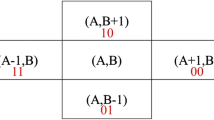Abstract
In the context of Reversible Data Hiding scheme (RDH), twin image-based methods have been widely used in recent years. Pixels of any cover image block are organized in ascending order and then modify the largest and smallest pixel to embed hidden information exploiting Pixel Value Ordering (PVO) techniques. The DPVO (Directional PVO) has been utilized in three orientations such as a horizontal, vertical and crosswise line applied one after other. Meanwhile, center folding method compresses the valuable hidden information and then embedded it within pixels of dual stego-images through averaging. The proposed scheme embed more than two data bits positions in any row of the image block which is possible by introducing a new parameter α, which was not reported by other PVO based RDH schemes. The Embedding Capacity (EC) is improved without compromising visual quality when the secret information is embedded using the center folding strategy combining with the DPVO scheme. The proposed method uses different image block sizes to demonstrate the relationship between the data hiding rate with visual quality of the stego image. The experimental outcomes indicate that the suggested method is suitable to embed high amount of hidden data with a good visual quality, that can be assured by comparing with other state-of-the-art methods. The intended result highlighted some impressive sublime features in the field of image identification, manipulation and forgery detection in which technical life stunts. This system profits enormously from numerous aspects of government and the private sector including education, economic protection, defence, intellectual property rights.















Similar content being viewed by others
References
Alattar AM (2004) Reversible watermark using the difference expansion of a generalized integer transform. IEEE Trans Image Process 13(8):1147–1156
Chang CC, Kieu TD, Chou YC (2007) Reversible data hiding scheme using two steganographic images. In: TENCON 2007–2007 IEEE Region 10 conference. IEEE, pp 1–4
Chang CC, Chou YC, Kieu TD (2009) Information hiding in dual images with reversibility. In: 2009 Third international conference on multimedia and ubiquitous engineering. IEEE, pp 145–152
Chang CC, Lu TC, Horng G, Huang YH, Hsu YM (2013) A high payload data embedding scheme using dual stego-images with reversibility. In: 2013 9th International conference on information, communications & signal processing. IEEE, pp 1–5
Coltuc D (2011) Improved embedding for prediction-based reversible watermarking. IEEE Trans Inf Forensics Secur 6(3):873–882
Fridrich J, Goljan M, Du R (2001) Reliable detection of LSB steganography in color and grayscale images. In: Proceedings of the 2001 workshop on multimedia and security: new challenges, pp 27–30
Hu Y, Lee HK, Li J (2008) DE-based reversible data hiding with improved overflow location map. IEEE Trans Circ Syst Video Technol 19(2):250–260
Kim HJ, Sachnev V, Shi YQ, Nam J, Choo HG (2008) A novel difference expansion transform for reversible data embedding. IEEE Trans Inf Forensics Secur 3(3):456–465
Kodak Lossless True Color Image Suite, http://r0k.us/graphics/kodak/. Accessed 11 Dec 2017
Lee CF, Huang YL (2013) Reversible data hiding scheme based on dual stegano-images using orientation combinations. Telecommun Syst 52 (4):2237–2247
Lee CC, Wu HC, Tsai CS, Chu YP (2008) Adaptive lossless steganographic scheme with centralized difference expansion. Pattern Recognit 41 (6):2097–2106
Lee CF, Wang KH, Chang CC, Huang YL (2009) A reversible data hiding scheme based on dual steganographic images. In: Proceedings of the 3rd international conference on ubiquitous information management and communication, pp 228–237
Li X, Yang B, Zeng T (2011) Efficient reversible watermarking based on adaptive prediction-error expansion and pixel selection. IEEE Trans Image Process 20(12):3524–3533
Li X, Li J, Li B, Yang B (2013) High-fidelity reversible data hiding scheme based on pixel-value-ordering and prediction-error expansion. Signal Process 93(1):198–205
Lou DC, Hu MC, Liu JL (2009) Multiple layer data hiding scheme for medical images. Comput Stand Interfaces 31(2):329–335
Lu TC, Tseng CY, Wu JH (2015) Dual imaging-based reversible hiding technique using LSB matching. Signal Process 108:77–89
Lu TC, Wu JH, Huang CC (2015) Dual-image-based reversible data hiding method using center folding strategy. Signal Process 115:195–213
Lu TC, Huang SR, Huang SW (2020) Reversible hiding method for interpolation images featuring a multilayer center folding strategy. Soft Comput. https://doi.org/10.1007/s00500-020-05129-7
Meikap S, Jana B (2018) Directional PVO for reversible data hiding scheme with image interpolation. Multimed Tools Appl 77(23):31281–31311
Meikap S, Jana B (2019) Directional pixel value ordering based secret sharing using sub-sampled image exploiting Lagrange polynomial. SN Appl Sci 1 (6):645
Nottingham Trent University, UCID Image Database. http://jasoncantarella.com/downloads/ucid.v2.tar.gz. Accessed 6 Nov 2019
Ou B, Li X, Wang J (2016) Improved PVO-based reversible data hiding: a new implementation based on multiple histograms modification. J Vis Commun Image Represent 38:328–339
Peng F, Li X, Yang B (2014) Improved PVO-based reversible data hiding. Digit Signal Process 25:255–265
Qin C, Chang CC, Hsu TJ (2015) Reversible data hiding scheme based on exploiting modification direction with two steganographic images. Multimed Tools Appl 74(15):5861–5872
Qu X, Kim HJ (2015) Pixel-based pixel value ordering predictor for high-fidelity reversible data hiding. Signal Process 111:249–260
Sachnev V, Kim HJ, Nam J, Suresh S, Shi YQ (2009) Reversible watermarking algorithm using sorting and prediction. IEEE Trans Circ Syst Video Technol 19(7):989–999
The National Library of Medicine presents MedPix®, https://openi.nlm.nih.gov/gridquery.php?q=&it=x. Accessed 11 Dec 2017
Thodi DM, Rodríguez JJ (2007) Expansion embedding techniques for reversible watermarking. IEEE Trans Image Process 16(3):721–730
Tian J (2003) Reversible data embedding using a difference expansion. IEEE Trans Circ Syst Vid Technol 13(8):890–896
University of California, Berkeley, “The Berkeley Segmentation Dataset and Benchmark”, http://www.eecs.berkeley.edu/Research/Projects/CS/vision/grouping/BSR/BSR_bsds500.tgz. Accessed 11 Dec 2017
University of Southern California, “The USC-SIPI Image Database”, http://sipi.usc.edu/database/database.php?volume=misc. Accessed 11 Dec 2017
Author information
Authors and Affiliations
Corresponding author
Additional information
Publisher’s note
Springer Nature remains neutral with regard to jurisdictional claims in published maps and institutional affiliations.
Rights and permissions
About this article
Cite this article
Meikap, S., Jana, B. Improved center-folding based directional pixel value ordering for reversible data hiding scheme. Multimed Tools Appl 80, 5617–5652 (2021). https://doi.org/10.1007/s11042-020-09823-4
Received:
Revised:
Accepted:
Published:
Issue Date:
DOI: https://doi.org/10.1007/s11042-020-09823-4




